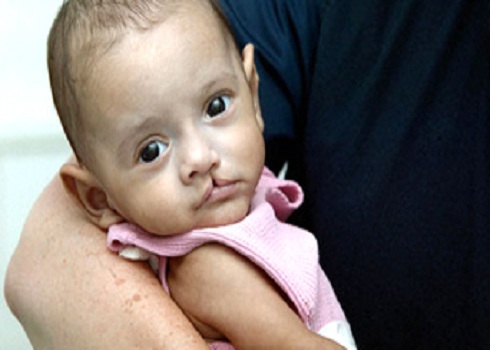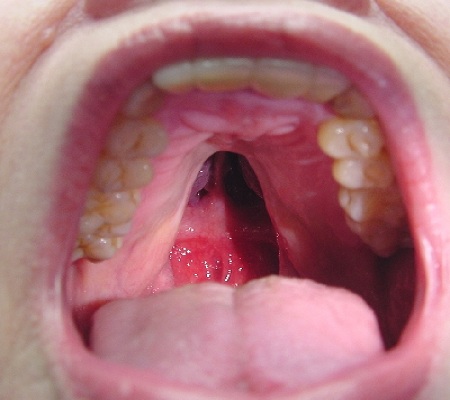Top 4 Cleft Palate Speech Therapy Techniques

Image source: Nhs.uk
Orofacial clefts, or cleft lip and cleft palate, are among the most common birth defects. In fact, according to KidsHealth, about 1 to 2 out of every 1,000 babies in the U.S. is born with clefts. This medical condition occurs due to improper development in the womb. If your baby has a cleft palate, it will almost certainly be diagnosed at birth. Your child’s pediatrician will evaluate him for treatment. Most of the time, surgery can help. However, surgery may not be performed right away, and your baby may need additional surgeries later on. Your little guy might still experience speech difficulties after surgery, which can be addressed by a speech-language pathologist (SLP).
Why Does a Cleft Palate Interfere with Speech?
The roof of your mouth has a hard palate and a soft palate. The hard palate, made of bone, is in the front, and the soft palate, made of tissues, is in the back. If your child has a cleft palate, it means that he has an opening in the palate. Velopharyngeal dysfunction (VPD) occurs when the opening between the mouth and the nose cannot close properly. This results in excessive airflow from the nose while your child is speaking, also called hypernasality. Although this can be corrected with surgery, some youngsters still experience VPD. Fortunately, one study of cleft palate patients indicated that the prognosis for achieving normal speech with the assistance of an SLP is quite good. Within about six to eight weeks of beginning speech therapy, your child should demonstrate measurable progress in his speech and language skills.
Additionally, children with a cleft palate often experience hearing loss due to middle ear problems. This can cause a speech delay because children acquire language by hearing it spoken. Bring your child to an audiologist and an ears, nose, and throat (ENT) specialist to prevent a speech delay.

Image source: Udent.com
Speech Therapy Techniques for Cleft Palate
Auditory Feedback
Auditory feedback is a crucial first step toward correcting speech patterns. The child must first learn to distinguish between normal speech and nasalized sounds. To that end, the SLP may use a variety of techniques. Your child may benefit from listening to recordings of normal and nasalized speech, or the SLP may simulate the two different types of speech. Little Johnny will then be asked to identify which type of speech is which.
Johnny may also be instructed to use a listening tube. One end of the tube will be held near the ear, while the other end will be placed just inside a nostril. He will then be asked to produce speech so that he can hear the nasality.
Articulation Practice
Speech therapy techniques for children with a cleft palate emphasize articulation practice.
Nasalized Plosives
A plosive is a sound that is produced when the vocal tract is obstructed by a speech structure, such as the lips or tongue. Youngsters with cleft palate produce nasalized plosives even after surgical treatment. This typically occurs when they improperly position the tongue. The SLP may have the child yawn in order to push the back of the tongue down. He will be asked to feel how his mouth stretches. As he yawns, he should practice producing the sound. He might use the listening tube at the same time.
Pharyngeal Plosives
A pharyngeal plosive is produced when the base of the tongue moves backward against the pharynx. The SLP will encourage little Johnny to make the “ng” sound. If he has trouble with this, a tongue blade may be used to press the tip of the tongue downward as the SLP presses upward under the chin. Once Johnny can successfully make the “ng” sound, he will be instructed to hold and drop the tongue to produce the “k” sound.
http://www.youtube.com/watch?v=T41wqeXtJbk
Pharyngeal Fricatives
A pharyngeal fricative is produced when the tongue is retracted but the base of the tongue doesn’t make contact with the pharyngeal wall. The SLP will first encourage your child to make a loud “t” sound, followed by a “ts” sound with his teeth closed. By rounding the lips, he can then practice the “ch” or “sh” sounds. Speech Buddies also offers tools geared toward these specific sounds. They provide tactile feedback within your child’s mouth so that he can understand the proper positioning of his tongue for the “sh” or “ch” sounds.
Palatal-Dorsal Productions
A palatal-dorsal production may result in a lateral lisp. They can often occur due to malocclusion of the teeth. The SLP may have your child bite down on a tongue blade that is positioned in such a way as to press down on the middle of the tongue. Your child will then practice producing sounds like the “t,” “d,” and “n” sounds, along with the “k,” “g,” and “ng” sounds.



Hi my name is Claudia, I also live in South Africa like Riki who wrote in. I also have a son- almost 3 now- born with a unilateral cleft soft palette, bilateral cleft hard palette and unilateral cleft lip. We are going to start speech therapy when he is 3. I wanted to tell Riki that if she is still looking for a speech therapist I can suggest she get in touch with Operation Smile South Africa as they might be able to advise of someone with Cleft experience in Pretoria or closer who can be of assistance or alternatively to call the Red Cross Children’s Hospital in Cape Town and speak to someone on the cleft team there and ask them to advise if they have any contacts that are close to her.
Best of luck Riki!
Kind Regards
Claudia
Hi
My son is now 3 years old. He had a cleft hard and soft palate and lip. He had 2 surgeries by the time he was 7 months old. There is still a small hole where the hard and soft palate meets. He went for speech therapy in 2012 and in the beginning of last year, but therapyst doesn’t do speech therapy any more. She was about 40KM from where we live. Now we live far from the cities (Naboomspruit, South Africa) and there are no speech therapysts nearby. The closest in in PTA about 160Km from us.
When is the time the child can learn most from a SLP? At what age. How often should he go (at the least)? What can I do to help him in the meantime?
Best regards
Riki
Dear Riki,
Thank you for your post. First, to answer your questions as best I can without having evaluated your son: generally speaking, it best to intervene as early as possible. That said, not every sound should be expected to be mastered by age 3. However, I would recommend having your child seen as soon as possible and if possible, by a specialist in craniofacial abnormalities like cleft palate. Once per week (of 30 to 45 minutes per session) would also probably be the minimum time indicated.
Living in a rural or less populated area can present a challenge for your search for the right speech therapist for your son. I actually share my office in downtown Brooklyn, New York with one of the world’s top authorities on treating speech disorders related to cleft palate. She said she would be available by teletherapy (i.e. Skype) for at least a consultation. Her name is Etoile Leblanc. Here’s her email: craniofacial@msn.com. She’s expecting to hear from you. She would also be able to give you exercises/strategies to help your son at home. Depending on the nature of your son’s speech challenges, Speech Buddies may also be an important part of his treatment.
I hope this helps and please keep us posted.
Gordy